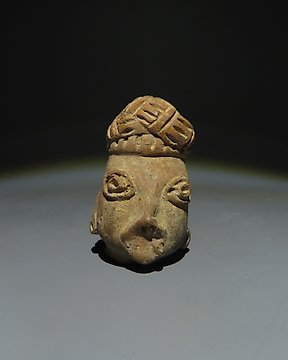
墨西哥特拉蒂尔科 Terracotta 摔碎。 公元前 1200-300 年。 4.7厘米。 “米歇尔·维纳维尔收藏”。 (没有保留价)
编号 84325065

编号 84325065

Anthropomorphic Figure.
Tlatilco, México,
Terracotta, 1200-900 BC.
14 cm height.
PROVENANCE: Private collection, Paris, France. 1970.
CONDITION: Good condition.
DESCRIPTION:
The Nicoya people lived on the Pacific coast and the Nicoya Peninsula, in what is now northwest Costa Rica. The rocky coastline here has just two bays but is rich in marine animals. The zone also offers wild fruit such as papaya and other resources such as wood and honey.
The Nicoya ceramic style is polychromatic and features the use of incisions and white and/or yellow painted geometric motifs over polished red slip. The most frequent forms are vase-shaped vessels with high, hollow bases, animal-shaped, globular or mammal-shaped vessels, and three-legged plates. Stylized painted jaguar motifs are also featured, as are pipes with a two-headed lizard. Serpents are another animal found frequently in Nicoyan art, especially in relation to fertility cults. The pantheon of Mexican deities is represented in images in red, blue, orange, sepia rose, black and grey paint. Pastillaje was another decorative technique they used. The stone statues the Nicoyans made feature naked men sitting with legs bent, elbows resting on the knees, holding an object near the mouth. The Nicoyan’s monumental sculptures are called “alter ego” because they are supposed to carry part of the individual they represent. These have a human-like form with a mammal or reptile on its back or head. Three-legged grinding stones with a hanging panel that joins the front leg have also been found, with half-human-half-animal figures. The underside of their grinding stones bear decorations that are meant to be visible when the stone is placed against the wall.
The Nicoya culture had its origins in previous cultures that inhabited the same zone, such as the Nicoya-Guanacaste, which mingled with Mexican ethnic groups that migrated after the theocratic empires fell and their land was taken over by military rulers. South American influences can also been seen, mainly in the Nicoyan’s copper work. Around 1500, the Nicoya people came into contact with the first Spanish conquistadors.
Notes:
- The piece includes authenticity certificate.
- The piece includes Spanish Export License.
- The seller guarantees that he acquired this piece according to all national and international laws related to the ownership of cultural property. Provenance statement seen by Catawiki.